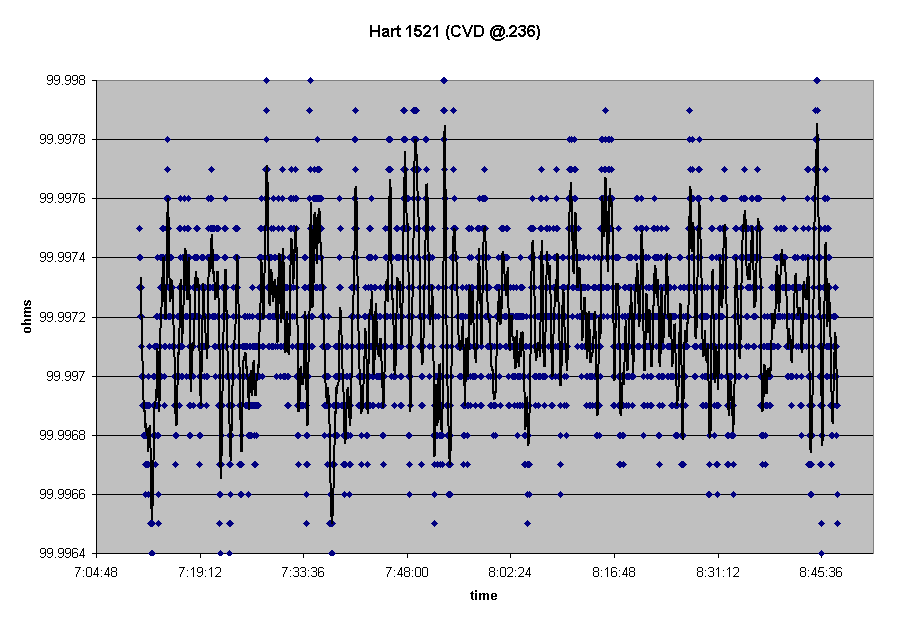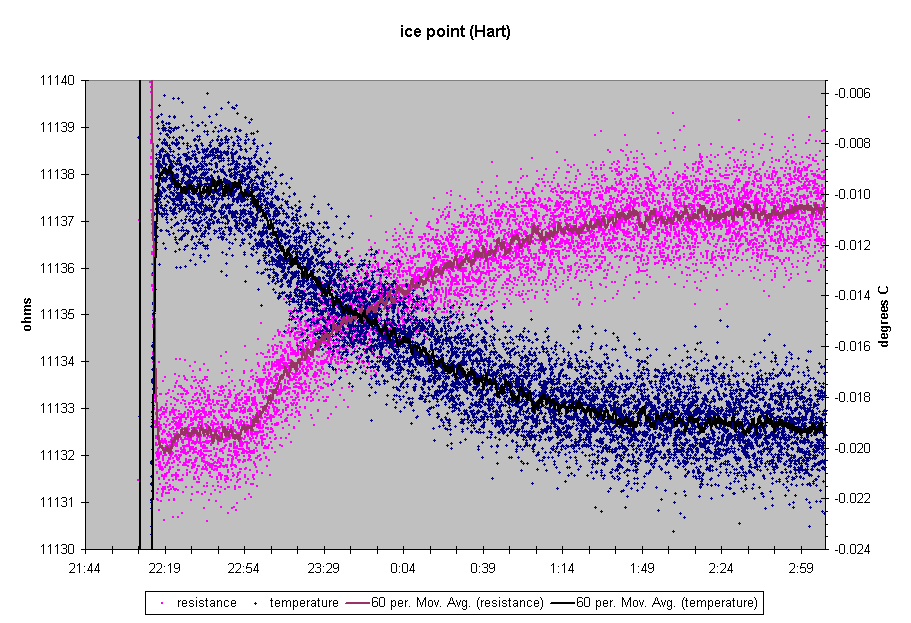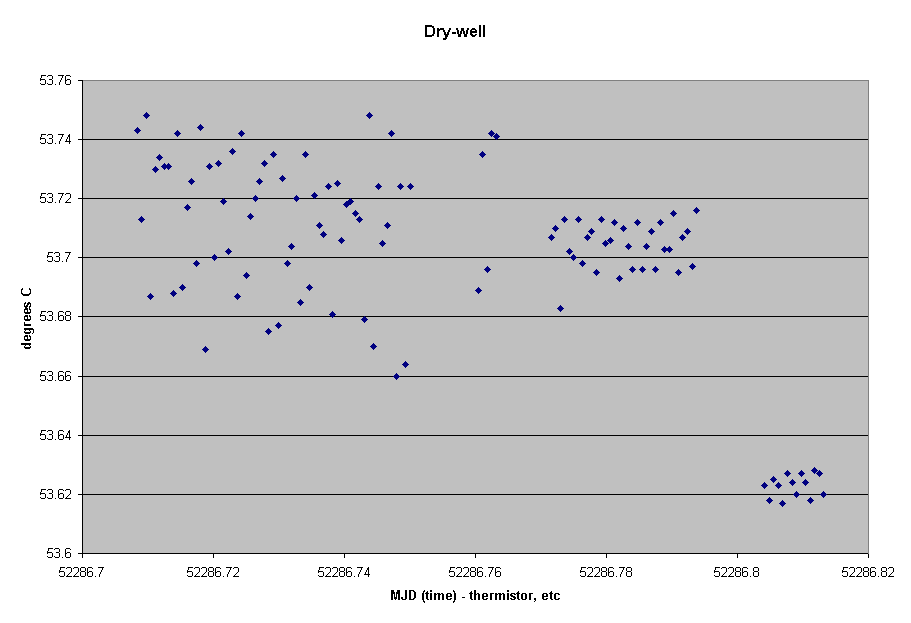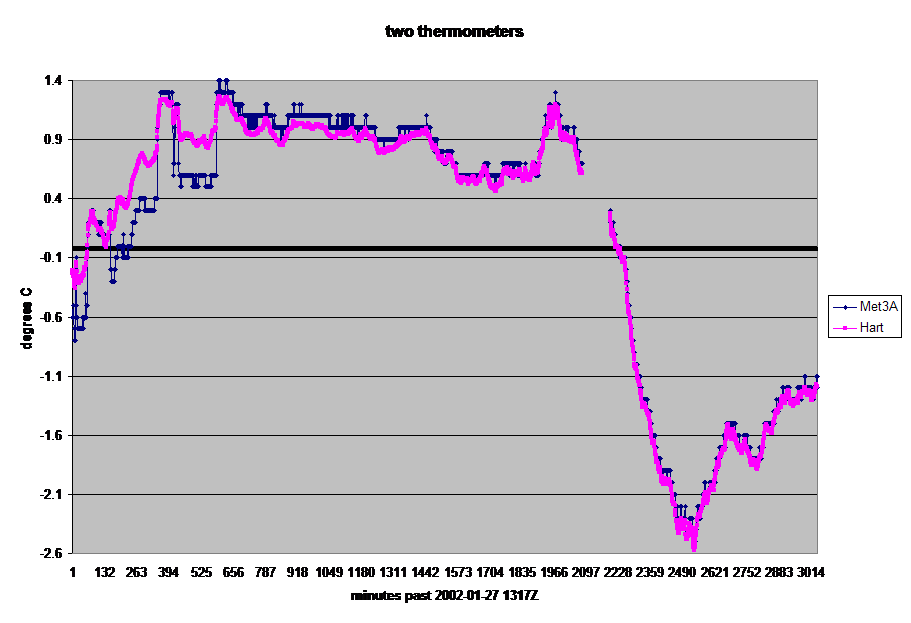
I have Hart Scientific's 1521 thermometer with 5641 thermistor standard (by Thermometrics), 5614 secondary reference PRT (by Burns Engineering), and 5627-9 precision industrial RTD. I also have a Kaye Ice Point Reference, and a Techne ESRB-7 Refrigerated Bath with Tempette TE-8D. I should be able to read better than .01°C from 0-60C, and better than .1°C from around -100 to 275C. Of course I wish that I had some TPW and MPGa cells and something to maintain them, but I'm too cheap.
The Kaye take about a half-hour to cool down, overshoots by ~.6°C for a few minutes, and then a few minutes later it starts cycling the front indicator off, which is a good indication it is about stable (the indicator cycles about 25 seconds off and 25 seconds on). A probe can easily take five minutes to cool down, and inserting a warm probe in neighboring well can cause ~.2C increase for five minutes. The four wells might vary ~.01C. Range seems to be around -.053C to -.01C (which is within the ±.1C spec of zero), commonly around -.024C to -.014C (-.019C).
The 1521 thermometer has a low and high resistance calibration. Each .001 ohm unit of the low calibration affects RTD by about .003C, and each .1 ohm unit of the high calibration affects thermistor by about .0004C. I have L&N 10K and 100 ohm standard resistors, so I warmed them up to just below 25C and measured with my HP 3457A slightly lower than the old calibration listed on the resistors (four 9s and a 6/7 instead of four 9s and an 8). The Hart measured ~99.998 ohms (so I did not adjust the low calibration value which was .236) and ~9998.3 ohms, so I added 1.2 to the high calibration value (now 8.2); that makes my thermistor read lower by <.009C. As detailed below, the Hart measurement noise was ~.001 ohm for the low and a little over 1 ohm for the high (below spec for the low, near spec for the high); I typically set the Hart's filter to 15 seconds, hoping to reduce the measurement noise. My ambient temperature is often at the lower range of "full accuracy" temperature for the 1521 (~60F).
I think my 5614 PRT reads ~.06C low (~.043C low near -.02C, ~.058C low near 25.6C, ~.09C low near 53.7C), which is slightly out of spec (it is past due for re-calibration). The 5627 RTD reads within ~.01C (~.011C low @25.6C and maybe also @53.7C, good @-.017C), while the thermistor is assumed correct.
More detail: I set a water bath to ~25.5C, insert a drinking glass partially filled with water, and insert a nominal 100 ohm standard resistor with four-wires into that glass (keeping the top/wires dry). I insert thermometer into resistor and wait for everything to settle (aiming for stability near 25C where the resistor was calibrated). The thermometer in the resistor reads ~24.8C (+/-.1C with .125" thermistor probe - a loose fit into the resistor), while the water in the glass was ~25.4C and the bath water was ~25.61C. The graph below begins with measurement by thermistor. I can't recall whether the measurement at the end was with thermistor or 5627, but it shows bath stability near +/-.01C or .015C

I then log the ~99.9983 ohm resistance from the Hart approximately every second. The average value (~99.9972) is useful for calibration, but the point of the chart below is to show the RTD measurement noise of the 1521. Measurement noise of +/-.0008 ohm equates to about .003C. Using a 15 second filter (represented by the black line) reduces the noise only slightly.

Since I care more about thermistor measurement than RTD, I switch to a nominal 10K (~9999.82) ohm resistor. The thermometer in the resistor read ~24.6C. Average value was ~9999.498 ohms, so I might bump the 1521 high calibration up by .1 (later - the effect would be to lower my thermistor readings by <.001C). 1521 measurement noise of 1.5 ohm equates to about .006C, but the filtering seems to reduce noise to about +/-.5 ohm or .002C.

Now that we've taken a look at the resistance and bath, we look at the ice point. The graph below begins with the cool-down at the left, mostly unseen due to the clipped Y scale. The recovery from overshoot is seen, and then it seems to settle around -.01C. Those readings were taken with thermistor. Then there is a short break followed by readings from the 5627 which are clustered around -.017C (except one outlier at -.011C). Then another short break followed by readings from the 5614 which are clustered around -.059C. Then another short break followed by a few more readings from thermistor and 5627 (both near -.018C). Perhaps the initial readings with thermistor might not quite have settled. The probes were then inserted into different wells and given time to settle (the longer break). The thermistor and 5627 readings are both near -.019C, followed by the 5614 which is around -.066C, finally followed again by the thermistor still around -.019C.

Below is a later, longer run of the Kaye. The left edge begins just over 100 minutes after power-on. The bulk of the data is from thermistor. The ~30 minutes around -.062C are from the 5614, then ~30 minutes of thermistor, then ~30 minutes from the 5627 (~-.017C), then back to the thermistor again (thermistor averaged ~-.019C).

Yet another ice point chart: For this one, I had the Hart output thermistor resistance almost every second, then I used its calibration equation to produce the temperature, and finally applied an approximate one-minute filter (to reduce the measurement noise, as seen earlier). This shows the approximate 30 minutes required for initial cool-down plus overshoot, and that it takes a couple hundred minutes to reach stability around -.0192C

Although the water bath is probably more stable up to almost 100C, for higher temperatures I have a King nutronics ThermoUnit Model 3603 dry-well with adapters for various width probes (the control knob needs to be set almost five degrees higher than desired). It takes about ten minutes to warm up, then seems stable within ~.1C (and reproducible). The chart below starts with thermistor (averaging ~53.71C), then was turned off and block reinserted for five more thermistor readings averaging ~53.72C. Then 5627 probe readings averaging ~53.7C, then 5614 readings averaging ~53.62C.

Next we move on to comparing to the outdoor thermometer that I log each minute. I thought such Paroscientific Met3A was accurate, but after about one year of operation I inserted the above-described Hart thermistor into the hole in Met3A's thermal block to come up with a -.795C calibration value. Although I should verify at other temperatures, after such fix, the two tracked within about +/-.2C (the Met3A averaged ~.033C low, so I could change the calibration value to -.762C). However, it seems that such thermal block might measure ~.8C warmer than a probe in nearby air?

I'm not sure what to say about the beginning of the chart below (created in order to verify colder temperatures than the chart above); maybe I'll search other Met3A recordings for such half-degree jumps near 0C. After that initial half-day, it could be said that the Met3A seems to read about .06C high at those low temperatures (acceptable).

When I got a cooler from Omaha Steaks, I tried my probes under the slab of
dry ice for a chance at seeing -109.3F (pressure was 29.74inHg)
My probe with black wire (5627-9) maybe got to -112.5F but later settled around
-109.2F
My probe with white wire (5614) seemed to respond slightly slower and maybe got
to -107.4F but later settled around -106.4F
To Doug's DSL (which has link to real-time surface measurements plus archived summaries, etc)